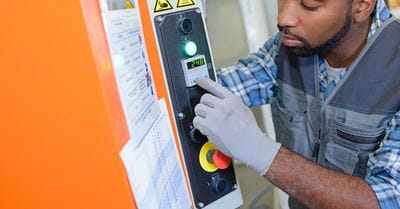Vertical Reciprocating Conveyors | Long Beach

Raymond West supplies warehouse automation equipment such as VRC's.
We are among the largest suppliers of warehouse automation equipment in the state.
Call us today at (562) 444-1222.
What Is a Vertical Reciprocating Conveyor (VRC)?
A VRC is an efficient, cost effective, simple means to transport goods from one elevation to another. VRCs have applications in many different industries, including factories, storage facilities, distribution centers, and other multi-level operations. These adaptable pieces of equipment can easily be incorporated into a structure’s basement, mezzanine, balcony or any upper floor levels.
VRC’s are made up of a shaft, a carriage, and a mechanical or hydraulic system. Vertical material lifts can be installed almost anywhere on the interior or exterior of a building. Gates and enclosures installed around VRC shafts keep workers safe and prevent accidents.
What Are Some Advantages of VRCs?
Safety: Many operations are dependent upon lift trucks to move their materials and merchandise from one level to another. While ideal for moving many different materials, forklifts are mainly designed for the horizontal transport of materials. In the name of efficiency, workers may occasionally take their forklifts beyond their vertical limit or transport goods in excess of their equipment’s capacity rating. When such infractions happen, the likelihood of an accident increase substantially.
For some vertical transport of goods between levels, VRCs provide a safe and effective replacement for forklifts. Specifically designed and fabricated for each operation’s application needs, VRCs greatly diminish the possibility of human error.
In addition, vertical material lifts are built to move more substantial loads more frequently. These faster cycle rates result in reduced labor expenses. For businesses that have high volume vertical transport requirements, vertical reciprocating conveyors can enhance safety and decrease costs.
Customization: One significant advantage of VRCs is the degree to which they can be tailored to specific applications. Because passenger elevators are designed to safely move humans, there are numerous regulations that constrain the weight capacity, speed and size of these mechanisms. Although such safeguards are necessary and advisable for safely moving humans, they are not necessary for high volume movement of products in production facilities, storage facilities and distribution operations. VRCs can be freely customized because they are not subject to the same regulations as passenger elevators.
Regulation: Vertical reciprocating conveyors are built to move freight only, while elevators are built to move both passengers and materials. Due to this fundamental difference, VRCs are free from the rigorous elevator standards in many states.
In place of local jurisdiction, VRCs are regulated by their own national code that is administered by the American Society of Mechanical Engineers (ASME), one of the original standards shaping associations in the nation. More specifically, vertical reciprocating conveyors must comply with ASME’s Safety Standard for Conveyor and Related Equipment (ASME B20.1-2018). This standard outlines the requirements for the construction, installation, operating procedure and maintenance of conveyor systems.
Raymond West Is A Full Service Supplier of Vertical Reciprocating Conveyors
If you’re starting the procurement process for a VRC, have questions or require engineering assistance, Raymond West can help. Our conveyor system experts can help design, procure, install and maintain a system that’s right for your operation. Call us today!
Raymond West's Long Beach service area includes Long Beach, North Long Beach, Wilmington, San Pedro, Lomita, Torrance and nearby surrounding areas.
Raymond West | Long Beach Material Handling Equipment Supplier
Long Beach
(562) 444-1222

